|
PREVIOUS
NEXT
.jpg)
.jpg)
MARCH 2010 - JANUARY 2011
.jpg)
.jpg)
.jpg)
Even now, while the eleventh Doctor enjoys his debut run of adventures on
tele-
vision, his tenth incarnation continues to explore time and space in IDW’s
latest Doctor Who comic series. Called Doctor Who Ongoing by
those in the know, and just Doctor Who on the cover, this
continuing series of adventures is still going strong in the US. Over here
in the UK, at least officially, readers have had to remain patient, and
wait for the
strips to appear over here
in graphic novel format...

Of the six issues collected here, the first two were originally released
under the title Silver Scream, but, even as they form their own
little adventure, they segue happily into the overall storyline of
Fugitive. We join the Doctor as he visits 1920s Hollywood (or
Hollywoodland, as it was then), where he gatecrashes a party in order to
meet one Archie Maplin. Yes, it does sound an awful lot like Charlie
Chaplin, but, bizarrely, rights issues prevented his use. Very strange
indeed;
I thought that sort of thing only applied to fictional properties, not
historical figures. Apart from the fact that references to Donna having
wanted to visit the period really draw attention to the fact that Maplin
is a stand-in, the character works
very
well, a Peckham wideboy living the life of a Hollywood star at the top of
his game. He’s a
wonderful
foil for the Doctor, more so than the two companion figures on offer here,
Matthew and Emily
-
a plucky investigator and a plucky would-be actress. Apart from being
ever-so plucky, they’re pretty nondescript for much of this, although
Emily gets surprisingly bloodthirsty at the end.
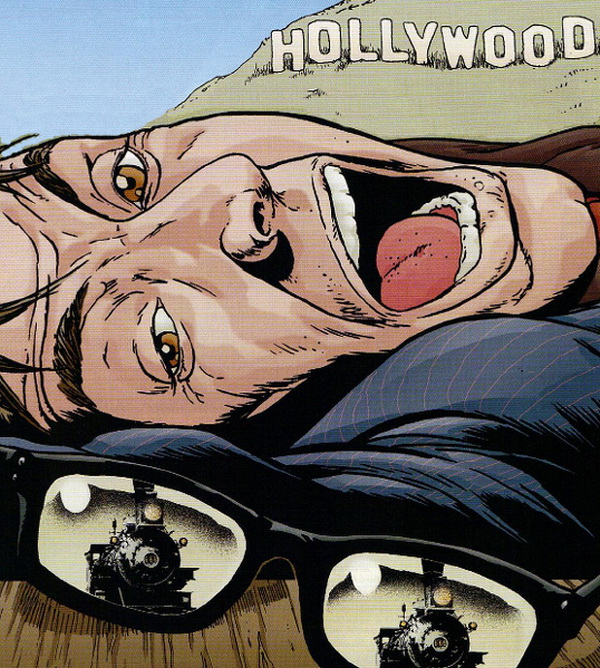
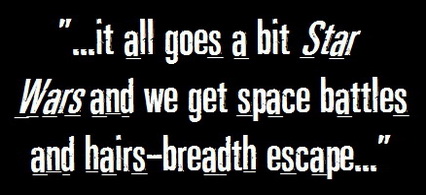 Long
story short, the Doctor Long
story short, the Doctor
and Archie have to stop two
alien Terronites, disguised
as a movie mogul and an
actor, from leaching away
young starlets hopes and
dreams so that they can use
them as charisma transplants
and boost their career. An
enjoyably barmy plan, that
one, and one that sees the Doctor placed in some of the most dire peril in
pure silent movie style. Author Tony Lee has great fun playing with the
clichés here, getting the Doctor into a showdown hanging from a clock face
and having him tied to train tracks like a damsel in distress. It’s not
the most eng-aging
story, but it’s good, old-fashioned fun. Sadly, Al Davison’s art isn’t
really up to scratch. It’s not bad, by any means, although his take on
David
Tennant veers from spot on to way off the mark, but it feels so terribly
static throughout. What should be great action scenes are portrayed with a
distinct lack of oomph, with the sole exception of a fine full-page
cliffhanger to issue
1.
Strangely, the only point at which his artwork really seems to fit the
story is when we see the action through a monochrome movie camera.
.jpg) It
all goes a bit pear-shaped for the Doctor when he saves Emily from It
all goes a bit pear-shaped for the Doctor when he saves Emily from
a fire in which she was, apparently, destined to die. It’s a static point
in time, you see, and the Shadow Proclamation scoop the Doctor up
in order to put him on trial for his interference, as the main body of
Fugitive begins. Now, in one way, this plays brilliantly with the Time
Lord Victorious events of The Waters of Mars, as the Doctor faces
the consequences of messing around with time. On the other hand,
however, he’s so blasé about it here that it’s hard to see why he got
so excited about changing history in that episode.
In any case, the Doctor’s on trial again. It’d have been nice to use
the comic medium to really bring the Shadow Proclamation to life,
but Matthew Smith (no, not that Matt
Smith) sticks to the rather dour space office block
we saw in The Stolen Earth. Still, there are a few more aliens
around this time, including shapeshifting Gizou, Krillitanes, Judoon and
the mysterious blue-skinned Advocate, and I really do like Smith’s art.
It’s simple, but very effective, with a Mark Mignola-esque vibe to
it. Naturally, the trial’s a big set up, and the prosecutor, none other
than Mister Finch (well, actually, you know that shape shifter I
mentioned…) is out to see the Doctor dead.
The Doctor finds himself imprisoned with Kraden, a Draconian diplomat
looking for peace;
Brarshak, a sensitive Ogron who hates the Judoon for
snaffling
all the mercenary contracts;
and Stomm, a Sontaran who wants alliances with other empires so that his
people can
just
focus on their fight with the Rutans. All three are being framed, like the
Doctor, and look destined to die, and all three are wonderfully written
characters. I especially like Brarshak, who almost passes out with the
effort of making a speech at one point. Lee builds up the show’s ongoing
mythology, but doesn’t forget to provide a rollicking adventure, as it all
goes a bit Star Wars and we get space battles and hairs-breadth
escapes while the Krillitanes attempt to derail the galactic peace talks.
It’s all tremendously good fun, and promises more to come, as the
mysterious mastermind behind the Krillitanes’ plans remains at large and
is keeping the Doctor in her sights. So, I look forward to Volume
2,
even if the Doctor does insist on picking up his two dreary
1920s
friends for a trip in the TARDIS.

Do you remember a couple of years ago, when
the
bizarre rumour that Richard Hammond was going to be taking over as the
Doctor
was doing the rounds?
This
seems to have been
based
entirely
on the fact that he looks - very vaguely - like David Tennant. Quite why
this rumour was
ever
lent any credence is beyond me, but looking at the artwork of Al Davison,
which
also features a Doctor who looks - very vaguely - like David Tennant,
you’d think that
the
casting had gone ahead.
This is symptomatic of the problems with Tesseract, the strip that
lends its name to volume
two
of IDW’s Doctor Who Ongoing range, collecting issues 7-12.
Davison’s art isn’t bad as such - he’s got a knack for creating some
interesting monsters - but he clearly struggles with drawing people. His
characters range from looking like different individuals from panel to
panel, to looking utterly peculiar, pulling expressions previously unknown
to mankind.
.jpg) Still,
the artwork is only half the problem with this story. Tony Still,
the artwork is only half the problem with this story. Tony
Lee now foregoes any attempt at a coherent narrative, and
lets his obsession with continuity take over completely. It’s
such
a shame, because there’s an interesting idea at the
heart of this strip, when the TARDIS collides with another
craft, folding in on itself and trapping the Doctor and his
new companions within its distorted geometry. However,
this
notion
is
trampled beneath
what feels like an
endless
parade of fannish references, with old Doctors’ costumes
making a gratuitous appearance on page one, followed by
the
‘shock’ appearances by earlier console rooms, and
allusions to Adric and Turlough. Don’t get me wrong, I enjoy
a continuity reference as much as the next geek, but there
needs to be a good story to hang it off. Tesseract collapses
rapidly into rather boring nonsense, with some truly terrible
dialogue that probably supposed to be knowing and funny,
but frankly isn’t.
Still, it’s a necessary part of the Ongoing story, since amongst
all this are some significant plot points in the continuing plot. The
blue-skinned villainess the Advocate returns
to the fray,
along with her shapeshifting Gizou ally from Fugitive, and plants
the seeds of doubt into the mind of Matthew Finnegan, who’s basically a
modern
version of Adric wearing a bow tie. Meanwhile, some very peculiar beings
calling themselves the Tef’Aree come into contact with Emily. This
mysterious, mythical beings exist outside of time, coexisting at all
points in their history at once. Unfortunately, it’s nigh on impossible
for even the most skilled of writers to produce dialogue or plot into a
non-linear environment without it rapidly collapsing into nonsense, which
is precisely what happens here.
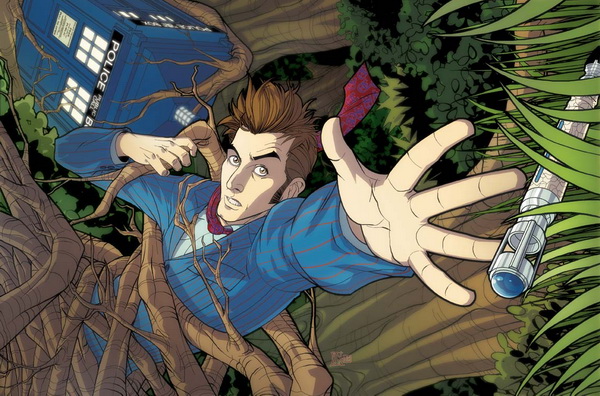
Things improve considerably for the second storyline, Don’t Step on the
Grass, a four-part story which comprises the bulk of this volume.
Martha Jones calls the Doctor back to Earth
to assist with a horde of killer trees. This latest UNIT adventure carries
on from Planet of the Dead, but satisfyingly, Lee takes an entirely
different tack to that adventure, putting the
Time Lord
at loggerheads with the military organisation, instead of all the recent
Doctor-fanboying and back-slapping. Blair Shed’s artwork is fantastic;
a massive improvement
on
Davison’s, with a fun, cartoony feel that is improved by the stunning
colour work by Charlie Kirchoff. This style brings out both the excitement
and humour
inherent in
the story - the Knights Arboretum, an ancient society of warrior
gardeners, are a wonderful creation, and the Enochian
Angels
are an effective monster race.
.jpg)
The Ongoing story comes to a head at the close of this story, with
Matthew swapping sides and joining the Advocate. The blue villainess
reveals some of her back story here - trapped for millennia in the Time
War, she desires revenge on the Doctor for his part in trapping her there,
due to his final devastating actions in time-locking the conflict.
Meanwhile, Martha is used well, her complex relationship with both UNIT
and the Doctor coming to the fore. The story even bridges the gap between
her televised appearances in Journey’s End and The End of Time.
More continuity points, yes, but this time they serve a purpose, and the
story. That’s the way to do it.

The final volume of IDW’s tenth Doctor adventures is concerned with tying
up loose ends
and bringing some closure to this incarnation’s adventures. Final
Sacrifice itself makes up the entire final run of Ten’s
Doctor Who
Ongoing
series, covering issues 13
through
to 16, after which the eleventh Doctor would take over. Also included in
this volume are the strips that featured in the American 2010 Doctor
Who Annual. The first, short strip is Old Friend,
a sweet story from the annual which ties directly into the main Final
Sacrifice storyline. The Doctor and Emily meet an old man who claims
to have travelled with the Doctor when he was young. It’s a poignant tale
of the Doctor dealing with someone who is both a future and former
companion.
This companion
happens to be called Barnaby Edwards, which I assume is a reference to the
multi-talented
Dalek operator,
writer and director.
It seems there
has to be some kind of fannish reference in all of Tony Lee’s scripts.
Barnaby also hands
the
Time Lord
the remains of Turlough’s journal - or, rather, his faked journal - last
seen in the hands of Matthew as he walked off with the Advocate. It’s now
in smoulders, which leads the Doctor to deduce Matthew is in trouble, and
this is a warning from his own future.
Tony Lee continues his authorship of the Ongoing run, with Matthew
Dow Smith providing a distinctive and effective artistic styl
that’s,
somewhat reminiscent of Mike Mignola’s Hellboy work. Final
Sacrifice resolves the stories of Matthew Finnegan, Emily Winter and
the Adv-ocate
that began with Silver Scream (and, indeed, ends with it, due to
the magic of time travel). I can’t say I feel Matthew made a particularly
successful companion in the long run; I found his insecurity and ‘tin dog
syndrome’ made him rather irritating, although it made him easily
manipulable which is precisely what this story required. Emily, on the
other hand, went from being a slightly aggravating woman with a chip on
her shoulder into being a forthright and eager companion. It might have
worked better if the Doctor had spent some time with her alone before he
was dragged back to Matthew and the Advocate.
At
least the Advocate proved to be an interesting antagonist, driven by
vengeance - and understandably so, as it was
the Doctor’s
fault that the Time War was locked up with her inside it.
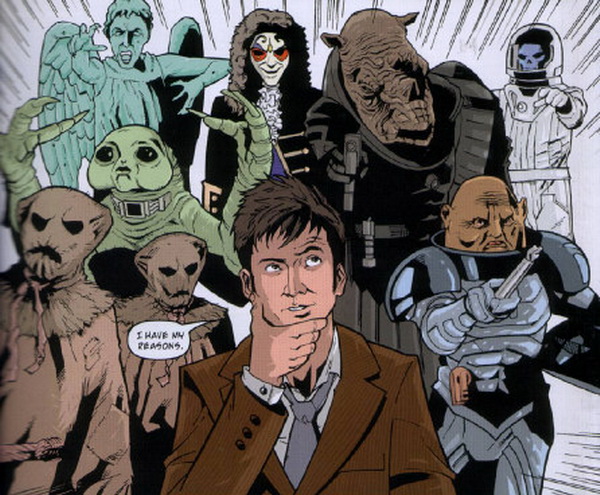
Due to the Advocate’s temporal manipulations, she and the Doctor are out
of sync. While it’s been days for him and Emily, it’s been two years for
her and Matthew. Things have changed, and now the Advocate’s shapeshifting
sidekick - finally receiving a name
here,
LauTan - has turned against her. While she’s set herself up as queen on a
war-torn planet, he’s leading the rebellion.
Not only that, but this story acts, to an extent, as a sequel to Lee’s
earlier one-shot,
The Time Machination, bringing in a group of
19th
century Torchwood operatives who
really
should know better than to
play
around with time tech. The Torchwood angle
helps to
keep things interesting, providing a similar antagonism as UNIT, only more
so, as they specifically see the Doctor as an enemy of the state. The
story is pretty eventful, full of double-crosses, as the Advocate attempts
manoeuvre those around her purely so that she can set the Doctor up, and
force him to sacrifice his companions. In the end, this is what happens,
with Matthew taking himself and the Advocate down together to save the
planet.
However, it’s not that simple, because the whole thing’s
one
big time loop. With the Tef’Aree - the
strange-looking
multidimensional superbeing(s) from Tesseract hanging around - it
was clear some temporal shenanigans would be going on. The revelation that
Matthew fuses with the Advocate when he destroys her, absorbing her
temporal powers and becoming the multi-dimensional
entity itself - well, it’s not just nonsense;
it’s predictable nonsense. We’re clearly supposed to go “Good grief! I
never saw that one coming!” but my reaction was more “Well, I thought it
was going to be something like that.” Similarly underwhelming is the
revelation that the planet was colonised by Earthmen. “Soul Free! Sol
Three!” cries the Doctor,
slapping his forehead as he
realises
the origin of one of the warring factions. Well done bullet. Likewise
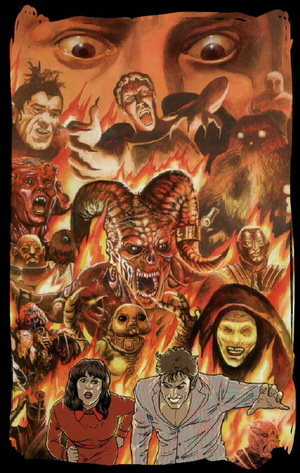 their
opponents, the Terror Farmers, either from their
opponents, the Terror Farmers, either from
terraformers or Terra Firma, depending on
the
panel. They even get revealed to be the origin
of the Terranites from back in Silver Scream,
which is only slightly
more surprising, in that it
wasn’t quite instantly obvious as soon as you
read the name. After all this, even Emily gets to
go back into her own timeline to set things up
for herself. Admittedly, it does tie everything up
with a nice big bow, but this kind of temporal
loopiness takes flair to pull off - this just ends up
being unsatisfying. It’s a shame, because the
bulk of the story is fun and diverting, and could
have ended the series on a high note.
There are a few more stories to fill time before
the tenth Doctor’s final bow, all taken from the
annual. With a script by Jonathan L Davis and
artwork
from
Kelly Yates, Ground Control is a
simple but enjoyable bit of fun, which sees the
TARDIS grounded by the Interstellar Traffic
Division. The spotty Mister K, who interrogates
the Doctor, is an unusually prosaic antagonist,
but all the more effective for it. It’s amusing to
see the Doctor grounded by such an operation.
There are also some alien space pandas, and
indeed, why not?
Matthew Dow Smith provides both words and pictures for The Big, Blue
Box, a strangely touching story about a living, robotic bomb that
could destroy the
whole
world. His name is Douglas. There’s very little plot to describe, but
that’s because it’s all in the characterisation. Easily the best story in
the book, in its quiet way. It’s certainly far better than the final
story, the shockingly bad To Sleep, Perchance to Dream. Al Davison
provides everything for this story from script to colours, but he has
nothing
at all
to be proud of. A pointless exercise in nostalgic fluff, this almost
dialogue-free
piece takes place inside the Doctor’s head as he dreams. Cue a wander
through a dreamscape populated by
past
companions and monsters
with no real story to speak of and little in the way of charm or interest.
Davison’s artwork is fairly good when he’s clearly copying from a
publicity shot, fairly dreadful otherwise, although some of the dreamscape
backgrounds are quite pretty. The only real item of note is IDW’s first,
very brief appearance by the eleventh Doctor. It’s probably supposed to
foreshadow the Doctor’s upcoming regeneration, but it comes across as just
another throwaway continuity reference. A poor conclusion to a volume with
its fair share of ups and downs.
|